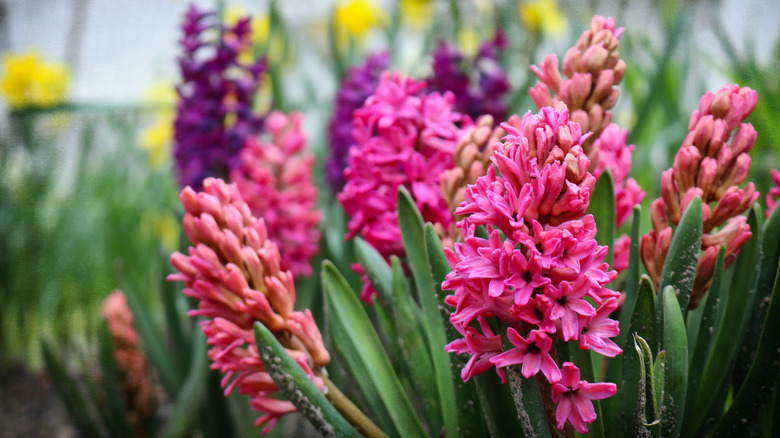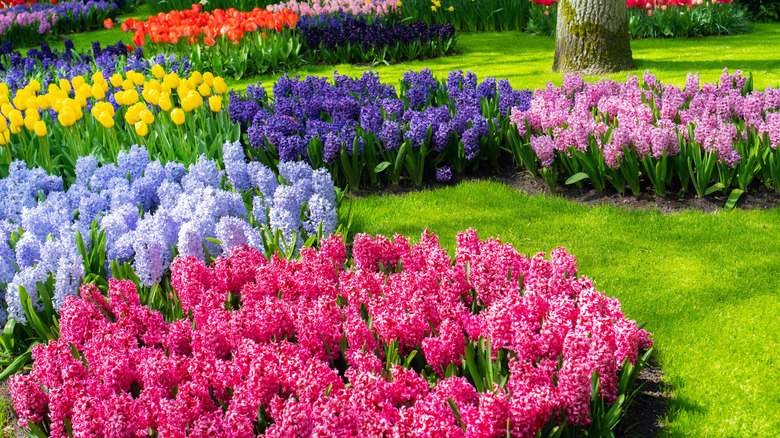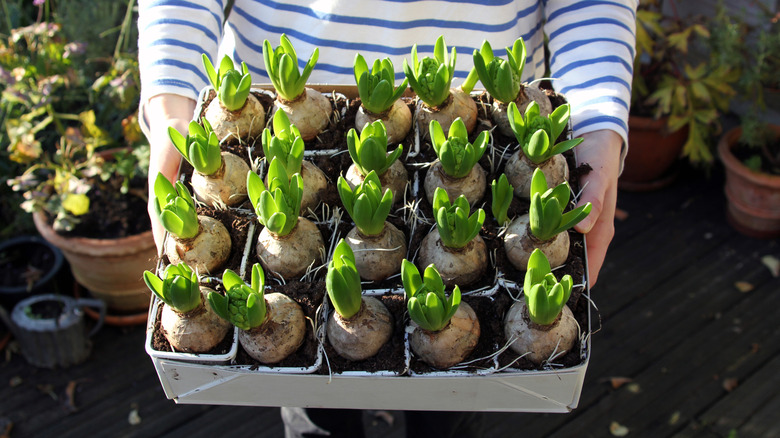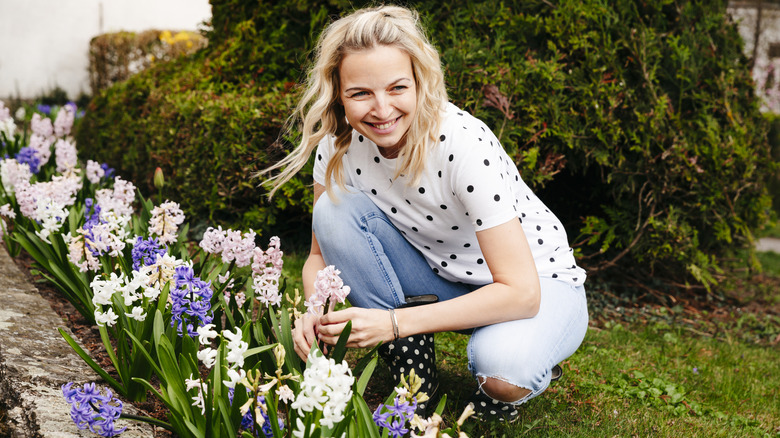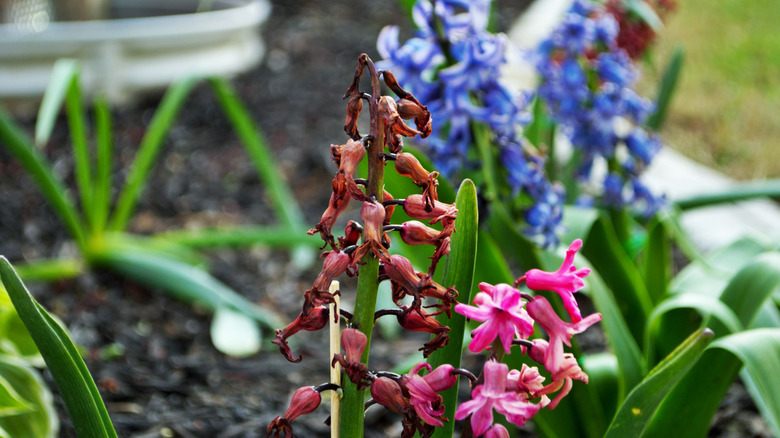Common Mistakes To Avoid When Planting Hyacinths In Your Garden
Hyacinths are a great garden plant because they are not only beautiful and fragrant, attracting all kinds of pollinators, but are also one of those perennials that keep coming back year after year. Not to be confused with grape hyacinths, which are an entirely different plant, true hyacinths are spring-blooming bulb flowers that come in almost every color. Although known today for being cultivated in the Netherlands, hyacinths are native to the Mediterranean and Eurasia and got their name from the story of Greek god Apollo who was said to have accidentally killed Hyacinthus and, in guilt and sadness, created beautiful flowers from his blood.
However, despite the long history and beauty of the hyacinth, the flower itself is actually pretty low maintenance and is a good place to start with if you are a beginner with bulbs. Another benefit of these flowers is that they contain a special toxin that makes them unappetizing to deer and rabbits, the two animals that typically devour other bulb plants like tulips. However, even though hyacinths are relatively easy to grow and take care of, it is possible to make some mistakes during planting that might cause these classic beauties to not thrive in your garden. So, to help you hyacinths reach their fullest potential, let's discuss a few common mistakes and how to avoid them.
Not researching the best variety of hyacinths for your garden
There are more than 60 different types of hyacinths that come in a range of colors and sizes. Choosing the one that best fits with your yard and garden will ensure that you can enjoy their beautiful blooms to the fullest. If you are looking for a shorter flower to line the front of your garden and not block the view of your other plants, then varieties that typically only grow to around eight inches (20 centimeters) — like the regal and almost-black midnight mystic, the deep-hued royal navy, the small but pretty white pearl, or the slightly taller pink pearl or blue star hyacinth varieties. While most hyacinths bloom for around two to three weeks, pink pearls are long bloomers and can flower for up to four weeks, making for a long-lasting and gorgeous choice.
However, if you are a fan of blooms that make a statement, you should choose a taller variety — 15 inches (40 centimeters) is typically the higher end of the hyacinth spectrum. Some lovely tall varieties of this flower include the bright pink jan bos, the orange Odysseus, and the cream-colored yellow queen. While hyacinths come in a rainbow of colors, if you aren't sure what color you want, you can also buy a pack of mixed bulbs to get multiple colors of these beautiful blooms.
On top of choosing the best variety of hyacinths for your garden, it is also important to purchase high-quality bulbs. You can usually find better bulbs from reputable bulb sellers who put time and energy into producing large bulbs that have more stored energy and will be able to create brighter and healthier flowers.
Not understanding when and how to plant hyacinth bulbs
Hyacinths are spring-blooming bulb flowers which means the best time to plant them is in the fall. The reason for this is that bulbs require a period of cold weather every year in order to start the chemical process that allows them to bloom. This means that they grow best in regions where winter temperatures are consistently at or below 30 degrees Fahrenheit (zones three or four through eight). As with most bulb flowers, the timing of planting them is important for their success. Hyacinths should be put in the ground around six to eight weeks before the first frost.
On top of planting your bulbs at the correct time, it is also important to place them at the correct depth and spacing. In general, hyacinth bulbs do best when planted around six inches deep in the soil with around five inches of space between each bulb. Furthermore, if you are new to bulb flowers, then it is important to know that many first-timers accidentally plant their bulbs upside-down. To make sure this doesn't happen, place the bulb in the soil so that the pointy side is facing up, otherwise you won't get any hyacinths come spring.
Planting your bulbs in the wrong area of your yard
Although hyacinths are pretty low-maintenance flowers, planting them in the wrong area of your yard can stunt their growth and cause them to produce lackluster blooms. To make sure that your hyacinths thrive, it is important to plant them in an area of your yard that receives full sun or only partial shade. Hyacinths generally prefer getting plenty of sunlight — usually around at least six to eight hours a day — although they will accept some afternoon shade in zones that are warmer. Luckily, because hyacinths tend to bloom in early spring before most trees have even grown leaves, too much shade usually isn't an issue for these early-bird flowers.
Another important thing to remember when choosing where you will plant your hyacinths is that they like well-draining soil and don't grow well in areas that get waterlogged. This is because hyacinths are sensitive to being too damp as it can cause a host of problems including bulb rot. Because of this, it is often recommended that you only water hyacinths when the soil around them is completely dry. Otherwise, you may end up overwatering them, which is one reason why a plant's leaves may turn yellow and then start to wilt.
Forgetting to care for your hyacinths at the end of the season
However, making sure you get the most out of your hyacinths doesn't just end with planting them in the right place in the fall and refraining from overwatering them in spring. After your flowers bloom, there is a little bit of care that you will need to put into these perennials to set them up for success in the next season. Firstly, hyacinths benefit from being deadheaded. This should be done after each bloom has died and is important because it helps prevent the flower from wasting energy producing seeds and, instead, continues to store that energy in the bulb for the following season.
However, when pruning hyacinths, you should only cut off the flowers and never get rid of any of the plant's leaves. This is important because the leaves actually serve as nutrients for the plant the following year, so removing them while they are still alive may affect your blooms during the next spring. However, when the plant has fully wilted and is completely done flowering, you can cut it back to just above the bulb to help it conserve energy for the winter. If you live in a colder climate, you may need to also protect your hyacinth bulbs during winter by covering the ground in a layer of mulch for insulation against single-digit temperatures.
Treating your potted hyacinths the same as your in-ground flowers
One great benefit of hyacinths is that they do just as well planted in the ground as they do in containers or pots. However, potted hyacinths need to be treated slightly differently than those planted in the ground. Firstly, it is especially important that you ensure your potted hyacinths have good drainage by putting a layer of sand, gravel, or clay at the bottom of the pot or container. On top of this, because potted plants are more susceptible to the cold, you may need to cover your pots with a bit of burlap or fleece to help protect them from bitter wind. If the temperatures where you live regularly get below 5 degrees Fahrenheit (-15 degrees Celsius), then you may need to relocate your hyacinth pots to a more sheltered area like a shed or porch during the winter season.
Lastly, when hyacinths are grown in containers, you may need to repot them after a few growing seasons if they become root-bound or the pot is too crowded with bulbs. The best time to repot your hyacinths is in spring after they finish blooming. This will give the plants enough time to grow new roots over the summer before going into dormancy again in winter. This way they will be ready to produce beautiful blooms again in spring.
